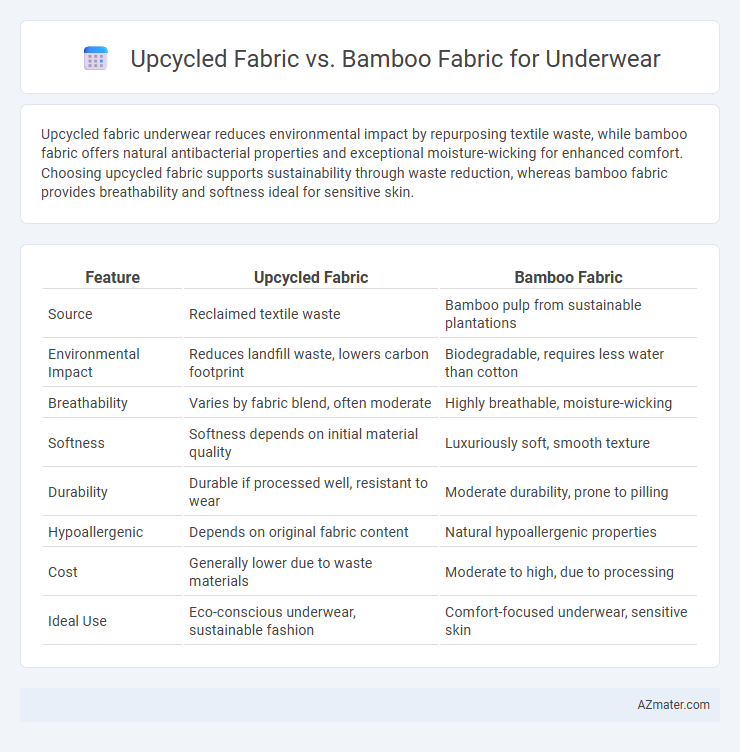Upcycled fabric underwear reduces environmental impact by repurposing textile waste, while bamboo fabric offers natural antibacterial properties and exceptional moisture-wicking for enhanced comfort. Choosing upcycled fabric supports sustainability through waste reduction, whereas bamboo fabric provides breathability and softness ideal for sensitive skin.
Table of Comparison
| Feature | Upcycled Fabric | Bamboo Fabric |
|---|---|---|
| Source | Reclaimed textile waste | Bamboo pulp from sustainable plantations |
| Environmental Impact | Reduces landfill waste, lowers carbon footprint | Biodegradable, requires less water than cotton |
| Breathability | Varies by fabric blend, often moderate | Highly breathable, moisture-wicking |
| Softness | Softness depends on initial material quality | Luxuriously soft, smooth texture |
| Durability | Durable if processed well, resistant to wear | Moderate durability, prone to pilling |
| Hypoallergenic | Depends on original fabric content | Natural hypoallergenic properties |
| Cost | Generally lower due to waste materials | Moderate to high, due to processing |
| Ideal Use | Eco-conscious underwear, sustainable fashion | Comfort-focused underwear, sensitive skin |
Introduction to Sustainable Fabrics in Underwear
Upcycled fabric and bamboo fabric represent innovative sustainable options transforming underwear production by reducing environmental impact and promoting eco-friendly practices. Upcycled fabric utilizes discarded textiles, minimizing waste and resource consumption, while bamboo fabric offers naturally hypoallergenic, moisture-wicking, and biodegradable properties sourced from fast-growing bamboo plants. Both materials highlight efficiency in circular fashion and renewability, appealing to consumers demanding responsible and comfortable underwear solutions.
What is Upcycled Fabric?
Upcycled fabric is created by repurposing existing textile materials, reducing waste and environmental impact compared to traditional fabric production. This sustainable approach transforms discarded fabrics or pre-consumer scraps into new, high-quality textiles ideal for eco-friendly underwear. Bamboo fabric, while biodegradable and naturally antimicrobial, relies on intensive processing, making upcycled fabric a more resource-efficient choice for sustainable underwear manufacturing.
What is Bamboo Fabric?
Bamboo fabric is derived from bamboo cellulose, known for its natural softness, breathability, and moisture-wicking properties, making it ideal for underwear. Its antibacterial qualities help reduce odor, while being eco-friendly due to bamboo's rapid growth and minimal pesticide needs. In comparison, upcycled fabric repurposes textile waste, offering sustainability, but bamboo fabric provides a unique combination of comfort, performance, and environmental benefits.
Environmental Impact: Upcycled vs Bamboo
Upcycled fabric for underwear significantly reduces waste by repurposing existing materials, lowering the demand for new textile production and conserving resources like water and energy. Bamboo fabric, while biodegradable and renewable, often involves intensive chemical processing that can negatively impact the environment unless produced via closed-loop methods. Overall, upcycled fabrics typically offer a smaller carbon footprint and less environmental degradation compared to conventional bamboo textile processing.
Comfort and Breathability Comparison
Upcycled fabric underwear offers moderate breathability and comfort, benefiting from reclaimed materials that often include cotton blends, which provide softness and moisture-wicking properties. Bamboo fabric excels in breathability due to its natural micro-gaps, allowing superior air circulation and moisture absorption, resulting in a cooler and drier feel. Both materials are eco-friendly, but bamboo fabric generally outperforms upcycled fabric in comfort and breathability for underwear applications.
Durability and Longevity of Each Fabric
Upcycled fabric offers significant durability due to its reprocessed fibers often derived from sturdy materials, making it resilient for everyday underwear wear. Bamboo fabric provides longevity with its natural strength and antimicrobial properties, which help maintain fabric integrity and freshness over time. Both fabrics contribute to sustainable underwear choices, but upcycled fabric tends to withstand frequent washing better, while bamboo fabric excels in comfort with moderate durability.
Skin Sensitivity and Hypoallergenic Properties
Upcycled fabric and bamboo fabric both offer hypoallergenic properties ideal for sensitive skin, but bamboo fabric excels due to its natural antibacterial and moisture-wicking capabilities, reducing irritation and bacterial growth. Upcycled fabrics vary widely depending on the source materials, making them less consistent but environmentally sustainable. Bamboo fabric's inherent softness and breathability provide a reliable choice for underwear designed to minimize skin sensitivity and promote comfort.
Production Process: Upcycled vs Bamboo Fabrics
Upcycled fabric for underwear is created by repurposing existing textile waste, significantly reducing environmental impact through decreased water, energy use, and landfill contributions. Bamboo fabric production involves processing bamboo fibers chemically or mechanically, requiring substantial water and chemical inputs, though it offers natural antibacterial properties. Comparing both, upcycled fabrics emphasize sustainability through resource conservation, while bamboo fabric integrates eco-friendly qualities with a more intensive production process.
Cost and Accessibility Factors
Upcycled fabric for underwear typically offers lower production costs due to its use of reclaimed materials, making it more affordable and environmentally sustainable. Bamboo fabric, while naturally antimicrobial and soft, often incurs higher costs because of intensive processing and limited large-scale cultivation. Accessibility challenges arise as upcycled fabric sources vary by region and supplier, whereas bamboo fabric benefits from growing demand but remains less available in mainstream markets.
Which Fabric is Better for Eco-Friendly Underwear?
Upcycled fabric reduces textile waste by repurposing existing materials, significantly lowering environmental impact compared to producing new fibers. Bamboo fabric, derived from a fast-growing renewable resource, offers natural antibacterial properties and biodegradability, but its processing can involve chemicals unless mechanically processed. For eco-friendly underwear, upcycled fabric often has a smaller carbon footprint, while bamboo fabric provides sustainable comfort if sourced and treated responsibly.

Infographic: Upcycled fabric vs Bamboo fabric for Underwear
 azmater.com
azmater.com